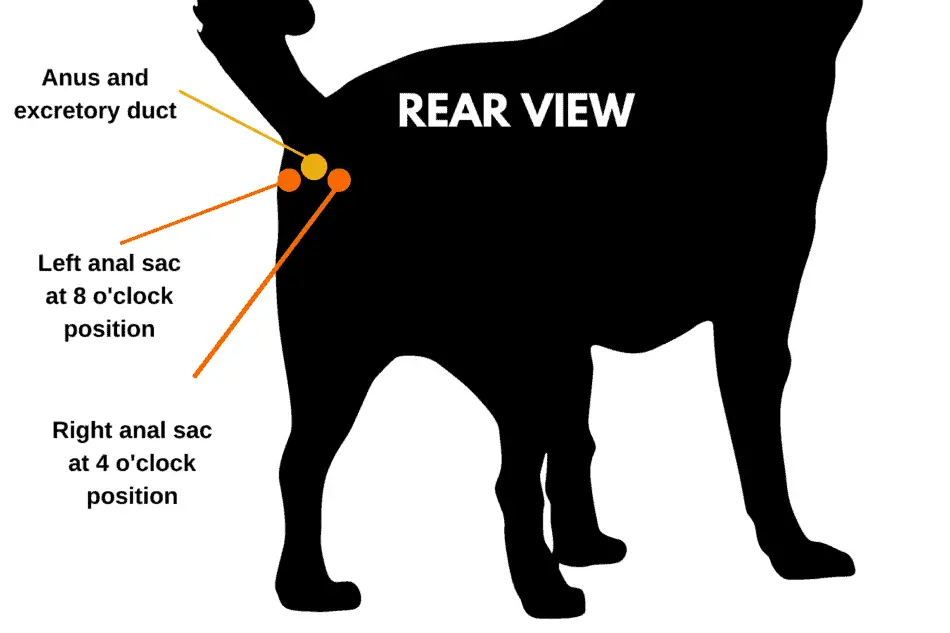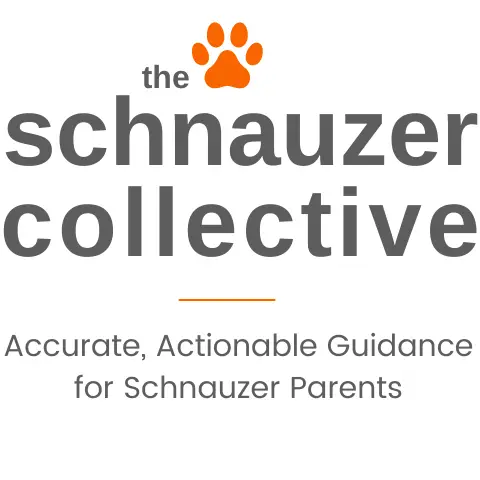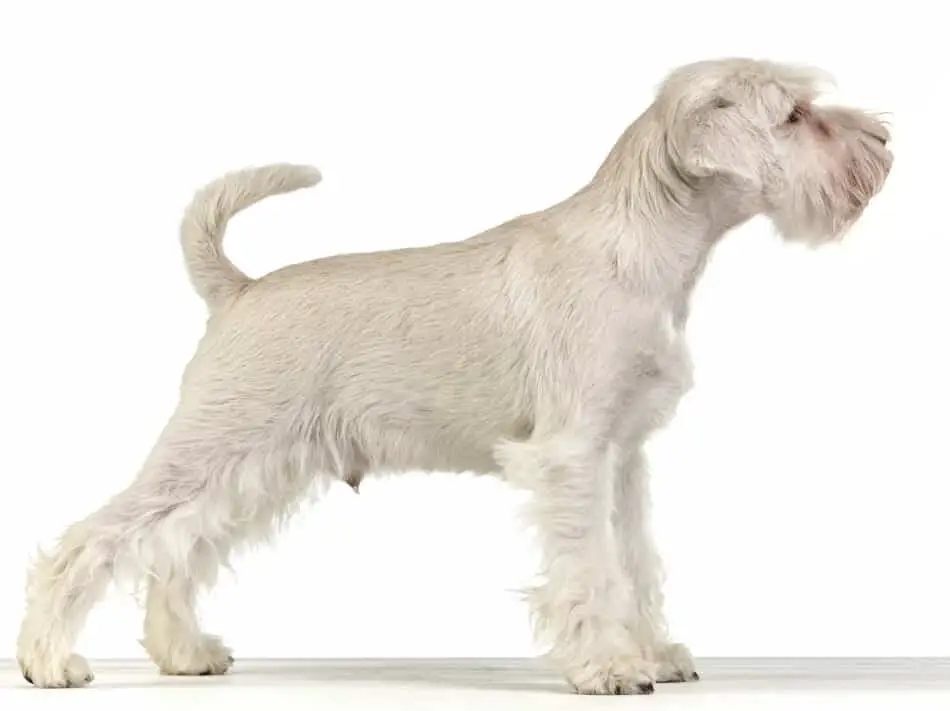The first time I took our Miniature Schnauzer to the groomer felt a little like sending her to a puppy spa retreat. Okay, it was our local groomer, but the services covered in the “Pampered Pup Deluxe Spa Experience” was more than I had ever even considered for myself. I lingered longingly over how they were going to clean, pamper, and groom her. Everything sounded so luxurious….until I noticed “anal sac expression.” Wait, what? As a new Schnauzer parent, I had no idea what this meant. It certainly didn’t sound pleasant. If you don’t know what anal glands are or why they may need to be expressed, read on. It’s important.
Anal gland expression is the process of locating both anal glands at the 4 o’clock and 8 o’clock positions and gently squeezing to eliminate the fluid. All dogs have anal glands and are generally able to release the fluid naturally when they have a bowel movement. However, small dogs, such as Miniature Schnauzers, may need help expressing the glands so they don’t become impacted.
Why Do Schnauzers Have Anal Glands?
Anal glands, also known as anal sacs, refer to two glands found on either side of your Schnauzer’s anus, under the skin. These anal glands’ function is to generate small amounts of secreted fluid that ranges from gray to yellow-brown in color. The fluid produced ranges from pasty to watery, and are extremely pungent.
Anal glands serve two significant purposes:
- Each time your Schnauzer defecates, his anal glands will receive some pressure, and the fluid is released. Anal gland fluids serve to facilitate bowel movements. Your Schnauzer might also involuntarily express them when alarmed or frightened.
- Anal glands serve to mark their territories and to help other dogs identify them. The secreted fluid is your Schnauzer’s unique scent, and the smell produced by these fluids informs other dogs about him.

Why Do Anal Glands Need to be Expressed?
Many Miniature Schnauzers do not suffer from swollen glands or experience any kind of problems with them whatsoever. If they are functioning correctly, it would be best to leave them alone.
However, if the anal glands cannot empty on their own or become impacted, you will have to intervene.
Your Schnauzer will give you a few signs that his anal glands need to be expressed. The most obvious signs include rubbing his bottom on the ground, excessive licking of the bottom area, a strong odor coming from his anus, and a brownish discharge left where he was sitting.

Here are four reasons your Schnauzer’s anal glands may need to be manually expressed:
Reason #1: To Prevent Infections and Disease
If left unattended, anal glands can result in an infection. One of the common infections is known as anal gland abscess. These infections can be very painful for your Schnauzer and costly for you. In the worst-case scenario, it can ultimately cause cancer. At this stage, the condition is usually hard to treat, and your Schnauzer may not recover.
Reason #2: To Maintain Motion and Health
When your Schnauzer has anal gland issues, his movement is greatly affected. The pain and discomfort that comes with the condition restrict him from moving freely. If he is experiencing regular anal gland problems, keeping him on a regular expression routine will be necessary. Work with your veterinarian and groomer to assess his needs.
Reason #3: To Prevent Foul Odors and Maintain Hygiene
Anal glands are known to produce a fishy, foul smell. If your Schnauzer is able to express his own glands naturally, you may even notice the foul odor during his bowel movements or possibly now and then on your carpet or bedding. However, impacted glands will begin to produce a consistent foul odor. You will also want read my article Why Does My Schnauzer Smell Bad (and What to Do) for additional reasons for bad odor.
Reason #4: To Prevent Scooting
If you’ve ever seen your Schnauzer scoot along the floor, you probably laughed right out loud. It’s one of the most comical things you’ll ever watch. Unfortunately, it’s also a sign of potential trouble. If it happens regularly, it also become a reason to manually express your Schnauzer’s anal glands.
Scooting can be a sign of impacted, non-draining anal glands and is covered below. But scooting also causes increased weight on his forelimbs as he drags his bottom on the ground. In addition to being hard on his forelimbs, the dragging may result in both irritation, inflammation, and possibly even infection.
How Often Should Anal Glands Be Expressed?
Most Schnauzers are able to naturally express their own glands during bowel movements or when they want to mark their territory. For many Schnauzers, these liquid-filled glands usually empty each time excretion occurs. For others, the glands might fail to empty, accumulate, and even become impacted. In severe situations, the anal glands may even rupture.
For example, smaller dogs such as Miniature Schnauzers sometimes need help.
If your Schnauzer is not able to naturally express his glands regularly and there are signs of problems (see the signs below), you’ll want to get on a regular manual expression schedule.
Some Schnauzers will only need a manual expression once or twice a year while others may need to be on a regular monthly schedule. If your Schnauzer displays any signs of trouble, work with your veterinarian to determine the best course of action and routine.
Signs that Your Schnauzer Needs Anal Expressing
If your Schnauzer’s anal glands are working well, there is no need to express them. However, if they cannot empty by themselves and they become impacted, then you need to act.
If the anal glands become clogged, the sacs might enlarge and start bulging due to the retention of bacteria and fluids. That can cause discomfort and pain for your Schnauzer. To prevent that from happening, you need to heed to any warning signs and consult with your veterinarian.
There are numerous signs that your Schnauzer requires his anal glands expressed. However, the severity of the noticeable symptoms varies from one dog to another. Some Schnauzers may exhibit several of the signs and, unfortunately, some may be more discreet and try to hide their discomfort and issues.
A good rule of thumb is to simply be alert to the signs and any changes in behavior.

Here are 5 tell-tale signs that your Schnauzer may need manual anal expression:
Sign #1: Irritated Anus
If the skin surrounding his anus has an irritated and swollen appearance, you need to express his anal glands.
Sign #2: Problems Passing Stool
If your Schnauzer is hesitant about passing his feces, it might be due to the discomfort caused by impacted anal glands. He might also react oddly if you unintentionally brush against his bottom.
Sign #3: Bad Odor
Anal sac fluid generally has very strong, awful odor. To some, it smells quite fishy. This pungent odor, especially if it remains after you consistently bathe your Schnauzer, is a clear sign that his anal glands need attention.
Sign #4: Chewing and Licking
Blocked anal sacs become itchy and irritated. Schnauzers will often try to find relief by chewing or licking the area around their bottom. In addition, oddly, they may try to find relief by chewing or licking any other areas that might also be itchy, such as their paws or ears.
If you notice that your Schnauzer is regularly chewing and licking any specific part of his body, take time to inspect the area. If everything seems clean and healthy, inspect his anal area.
Sign #5: Dragging or Scooting
Swollen anal glands do not sound pleasant and will definitely not feel right to your Schnauzer, either. The mounting pressure of the blocked glands causes a lot of discomfort for your Schnauzer, and he may try to find relief by dragging his bottom over the floor. If you notice that he prefers scooting his booty on the ground, check the condition of his anal glands.
What are Your Options for Anal Expressing?
While covering the topic of anal glands and the potential trouble they can cause is not pleasant, the solution to problems is even less pleasant.
If you Schnauzer needs his anal glands manually expressed, you have two options: learn how to do it yourself, or enlist the expertise of your groomer (for general maintenance) or your veterinarian (to address serious problems).
To be honest, I think it’s better to leave this to your groomer or veterinarian, but I do want to include the at-home steps just in case you need them.
How to Express Anal Glands at Home
If your Schnauzer is not oozing pus or bleeding around his anus, it is safe for you to express the anal glands yourself. To express the anal glands at home, follow the steps outlined below.

Supplies You Will Need:
- Disposable latex or plastic gloves
- An apron or clothing covering
- Vaseline or any other lubricant
- A warm and soapy washcloth
- Paper towels
Follow these steps:
- Wear some type of clothing covering such as an apron. Wear gloves. The process can be messy. Additionally, the protective gear protects you from germs that reside in the anal glands.
- Fold several paper towels together to form a pad for liquid absorption.
- Lift your Schnauzer’s tail. If his tail is docked, the anus will probably already be exposed.
- Lubricate his anus with the petroleum jelly.
- Place the folded paper towels over his backside and cover his anus.
- Using your thumb and forefinger, squeeze gently at the angle of 4 o’clock and 8 o’clock as if the anus area is a clock face.
- Catch the anal sac liquid in the paper towels.
- Dispose of the towels safely in a well-covered rubbish basket.
- Wash his bottom thoroughly or bath him.
Have Your Groomer or Veterinarian Do the Expressing
If you don’t want to express the anal glands on your own or if the problem has become serious, you should have your veterinarian or groomer handle it.
For someone who is experienced, anal expressing is a simple task that takes as less than five minutes to finish. You can request the procedure as part of your Schnauzer annual veterinary checkup and add it on to the services your groomer performs.
Don’t be afraid to delegate this task to your veterinarian or groomer.
THE SCHNAUZER COLLECTIVE
How to Handle Anal Gland Problems
If your Schnauzer’s anal glands are blocked, infected, or even seem to have ruptured, it’s essential to make an appointment with your veterinarian as soon as possible.
How to Treat an Anal Gland Infection
An anal gland infection will be very painful for your Schnauzer. It’s imperative to contact your veterinarian if his anus is red and swollen, and if he exhibits any of the other signs listed above.
Your veterinarian will probably recommend a course of action such as:
- Medication. A gland abscess is extremely painful and your Schnauzer will probably not let you help him until the pain has been addressed. He will probably need both a pain reliever and antibiotics.
- Expression. Infected anal glands are best left to veterinary care. Do not attempt to express them yourself. If your Schnauzer has been taking medication for pain relief and infection, and has become more comfortable, your veterinarian will most likely gently examine and express his glands without bursting them.
- Additional Treatment. If the infection is not eliminated, your veterinarian may swab the abscess. This will help to determine which antibiotic will be the most helpful.
- Possible surgery. If your dog’s glands are too difficult or painful to express despite medication, your veterinarian may recommend flushing them under anesthetic. If the problem persists, surgery to remove the affected gland(s) might be considered. However, this is a last resort because surgery on the anal area comes with a high risk of infection and complications.
How to Treat a Burst Anal Gland
Once an abscess has burst and is open to air, it is generally much less painful. The treatment and healing process consists of:
- Keep the area clean. Your veterinarian will clip the surrounding hair and clean the area thoroughly. At home you will need to follow any veterinary instructions, which may include using warm salty water and cotton pads to clean the area twice daily, and after every bowel movement. Your Schnauzer will need to wear a head cone until their abscess has fully healed. This is to keep him from licking the area. The bacteria inside his mouth could cause further infection.
- Offer Medication. Once one or both anal glands have burst, antibiotics are generally not necessary. However, your Schnauzer will most likely be given an anti-inflammatory pain reliever.
- Keep a Healing and Expression Schedule. Most anal gland abscesses heal within a week of beginning treatment, as long as they are kept clean and there are no complications. If your Schnauzer has ongoing problems with his anal glands, they may need to be emptied on a regular basis. Your veterinarian will tell you if, and how often, his anal glands need to be expressed.
How to Prevent Anal Gland Problems
None of us want to see our Schnauzer suffer with impacted, infected, or burst anal glands. Luckily, most Schnauzers won’t have problems.
However, if you have a Miniature Schnauzer and are worried about potential anal gland problems because of his small size, here are some things you can do to help prevent issues (and these are great overall suggestions for Standard and Giant Schnauzers as well):
- Maintain a healthy weight. Miniature Schnauzers should generally weigh between 10-20 pounds. Schnauzers are prone to weight gain and you will want to help him watch the scale. Overweight dogs generally have weaker sphincter muscles which makes gland emptying more difficult.
- Offer high–quality dog food. Just like human bodies, canine bodies function best when they are filled with highly nutritious food that meets essential nutritional requirements. Consider offering only high-quality kibble or human-grade dog food.
- Schedule regular check-ups. Maintaining an annual check-up schedule is good for overall health. If your Schnauzer is suffering from anal gland problems or any other chronic health issue, your veterinarian can also recommend a more frequent check-up schedule.
- Add Fiber. Adding extra fiber to your Schnauzer’s diet will help firm up his bowel movements. As a result, when your dog goes to the toilet their stool will press on the anal glands and help to empty them. You will want to check with your veterinarian for fiber recommendations, but you could consider adding wheat germ, ground flaxseed, canned pumpkin (not pie filling), apples, and green beans.
And finally, from one pet parent to another, discover my all-time favorite resources designed to cover your every Schnauzer need. I’ve done the legwork for you so you can spend more time with the people and fur friends in your life.
A portion of all profit earned on this site is donated to Pet Partners
whose mission is to improve human health and
well-being through the human-animal bond.
They train and register pets to become therapy animals,
and have local chapters in many states.

